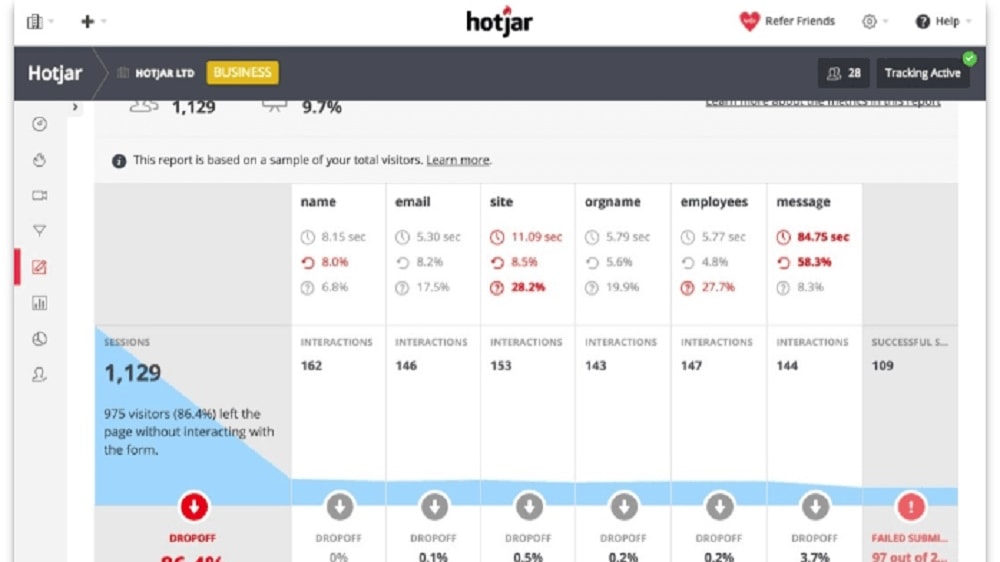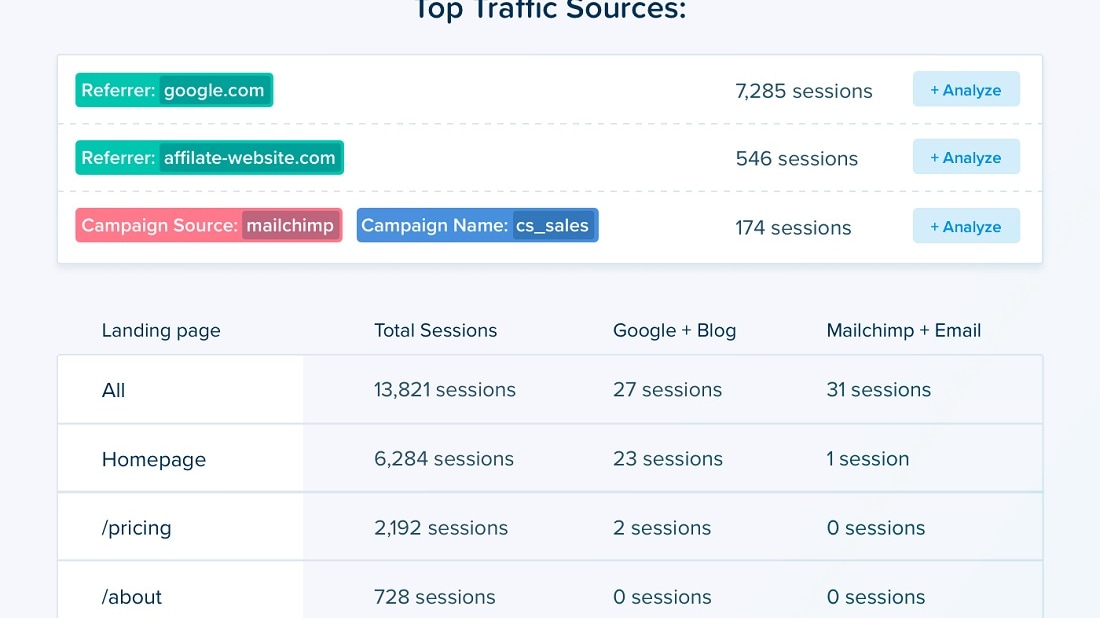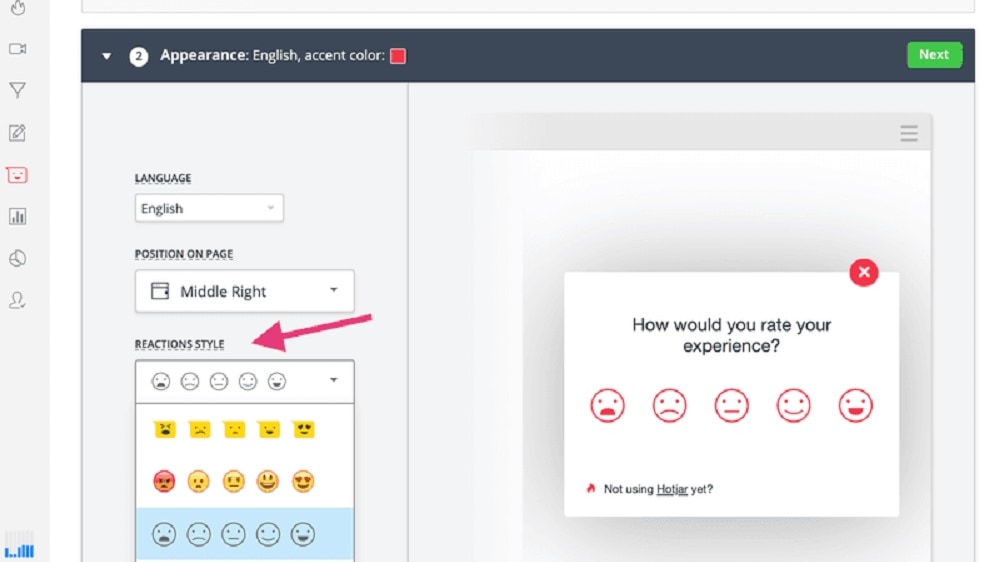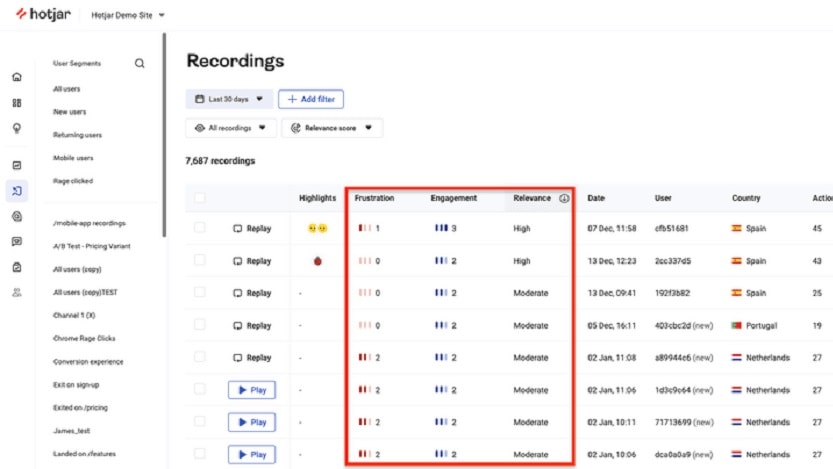Hotjar vs Crazy Egg: What’s the best heatmapping tool?
- 01Hotjar vs Crazy Egg: overview
- 02What's the difference between Hotjar and Crazy Egg?
- 03Hotjar pros and cons
- 04Crazy Egg pros and cons
- 05Hotjar compared to Crazy Egg
- 06Crazy Egg compared to Hotjar
- 07Features comparison
- 08Hotjar vs Crazy Egg: Which is the best for your business?
- 09Promotions on Data Analytics software
- 10Alternatives to Hotjar & Crazy Egg
Save up to $99 on Hotjar
Hotjar
1 month free on Business plan
Save up to $99 on Hotjar
Hotjar
1 month free on Business plan
Efficient website analytics tools are essential for understanding user behavior and optimizing your online presence. Hotjar and Crazy Egg are two well-known options in this field, both offering valuable insights into how users engage with your website. However, they have distinct features and advantages that cater to different needs.
In this article, we'll conduct a detailed comparison of Hotjar vs Crazy Egg, analyzing their key features, pricing models, and primary differences. By the end of this comparison, you'll be better equipped to choose the website analytics tool that aligns best with your website's goals and requirements.
Hotjar vs Crazy Egg: overview
Hotjar and Crazy Egg are two prominent contenders in the realm of website analytics tools, each offering its own distinct set of features tailored to cater to the diverse needs of website owners and marketers.
Hotjar is renowned for its user-friendly interface and a suite of tools that include heatmaps, session recordings, and feedback surveys. It excels at providing visual insights into user behavior, helping businesses identify areas for improving website usability and conversion rates. In contrast, Crazy Egg offers similar features such as heatmaps, scroll maps, and A/B testing, with a focus on visualizing user interactions and optimizing web design.
Now, let's embark on an in-depth comparison of Hotjar vs. Crazy Egg to assist you in making an informed decision when choosing the most suitable website analytics tool for your specific website optimization goals.
What's the difference between Hotjar and Crazy Egg?


If you’re strapped for cash, and you don’t have a lot of traffic, Hotjar’s the best pick. Its free plan is enough to generate useful insights for small sites. Other than that, we recommend Crazy Egg.
For starters, Crazy Egg’s data limits are ampler. You get 30,000 tracked visits per month with their cheapest plan, compared to Hotjar’s 3,000 visits at the same price point.
As for the core tool - heatmapping - both options are decent. They generate valuable reports, and accurately track user sessions to give you an interactive map of your site’s UX. But Crazy Egg still comes on top, because it’s better for tracking individual users thanks to its Snapshots, error tracking, and more.
Not to mention, Crazy Egg has a better marketing suite. Both platforms offer more or less the same features for marketing. But some tools are available right away in Crazy Egg, like A/B testing. Comparatively, you’ll need to install extensions to get the same features in Hotjar.
Another thing people consider when picking a new tool for their site is performance. Google’s pretty strict about your site’s loading time, so it’s important to only use tools that will have a minimal impact on loading time.
In our testing we found that both tools have a negligible impact on loading time. But more users have reported problems with Hotjar. So if SEO’s an important part of your strategy, Crazy Egg is the better choice.
Hotjar pros and cons
What are the advantages of Hotjar?
- User-friendly interface: Hotjar's intuitive interface makes it accessible to users of all skill levels, allowing you to quickly set up and start analyzing user behavior on your website.
- Multiple insights: Hotjar offers a wide range of tools, including heatmaps, session recordings, feedback polls, surveys, and more, providing comprehensive insights into user behavior and preferences.
- Visual data: Hotjar excels in providing visual data through heatmaps and session recordings, making it easy to identify user interactions and areas for improvement.
- Affordable pricing: Hotjar offers competitive pricing plans, making it accessible to businesses of various sizes, and a free plan is available for basic use.
- Feedback collection: Hotjar allows you to gather user feedback through surveys and polls, providing qualitative insights and suggestions for website improvements.
What are the disadvantages of Hotjar?
- Limited A/B testing: Hotjar's A/B testing capabilities are relatively basic compared to dedicated A/B testing tools, which may not meet the needs of users requiring advanced experimentation.
- Session recording limits: Depending on your plan, Hotjar may limit the number of session recordings you can store, which can be a limitation for high-traffic websites.
- Privacy concerns: While Hotjar takes privacy seriously and offers masking options, session recording tools have the potential to capture sensitive user information if not configured correctly.
- Learning curve for advanced features: While user-friendly, mastering Hotjar's advanced features, such as setting up complex surveys or analyzing conversion funnels, may require some learning.
- Integration challenges: Some users may encounter integration challenges with specific website platforms or content management systems, requiring technical expertise to resolve.
Compare Hotjar to other tools
Crazy Egg pros and cons
What are the advantages of Crazy Egg?
- Heatmaps: Crazy Egg offers detailed heatmaps that visually display where users click, move their cursors, and scroll on your web pages. This helps identify user engagement and interaction patterns.
- A/B testing: It includes A/B testing functionality, allowing you to create and compare different versions of your web pages to optimize conversion rates.
- User-friendly: Crazy Egg is known for its user-friendly interface and easy-to-use features, making it accessible for both beginners and experienced users.
- Scroll maps: The tool provides scroll maps that show how far users scroll down your web pages, helping you understand if users are reaching your key content.
- Confetti reports: Crazy Egg's Confetti reports provide granular data about individual clicks, enabling you to analyze clicks based on various attributes like traffic sources, devices, and more.
What are the disadvantages of Crazy Egg?
- Pricing: Some users find Crazy Egg's pricing relatively high, especially for smaller businesses or those with limited budgets.
- Limited integrations: While it offers integrations with popular platforms like WordPress and Shopify, Crazy Egg may not have as many integrations as other similar tools.
- Session recordings: Crazy Egg lacks session recording capabilities, which are available in some competing analytics tools for a more comprehensive view of user behavior.
- Limited free plan: Crazy Egg does not offer a free plan, which may deter users looking for no-cost or trial options.
- Learning curve for A/B testing: While user-friendly, setting up and interpreting A/B tests may require some learning for users new to the concept of split testing.
Hotjar compared to Crazy Egg
Hotjar and Crazy Egg are both influential tools for website optimization, but each offers unique strengths. Hotjar stands out with its user-friendly interface, encompassing features like heatmaps, session recordings, and feedback tools. It excels in visually representing user behavior data, simplifying the process of enhancing the user experience.
In contrast, Crazy Egg offers a suite of tools for heatmapping, scroll tracking, and A/B testing, emphasizing visualizing user interactions. The choice between Hotjar and Crazy Egg depends on your specific needs; Hotjar for user-friendliness and visual insights, and Crazy Egg for its comprehensive heatmapping and A/B testing capabilities, making it valuable for in-depth website optimization.
Is Hotjar better than Crazy Egg?
Determining whether Hotjar is better than Crazy Egg depends on your specific goals and priorities. Hotjar is favored for its user-friendly interface and robust feature set, including heatmaps, session recordings, and user feedback tools, making it an excellent choice for those looking for comprehensive insights into user behavior. Its strength lies in visual data representation.
Crazy Egg, on the other hand, is known for its advanced heatmapping capabilities and A/B testing features, making it a go-to choice for in-depth website optimization. Whether Hotjar is better than Crazy Egg depends on your needs for usability and visual insights versus a focus on advanced heatmapping and A/B testing capabilities.
What is Hotjar best used for?
Hotjar is best utilized for optimizing websites by providing valuable insights into user behavior. Its robust suite of tools includes heatmaps, session recordings, feedback polls, surveys, and more, offering a comprehensive understanding of how visitors interact with your site.
Hotjar excels in visually representing user data through heatmaps and session recordings, making it easy to pinpoint areas for improvement in web design, user experience, and conversion rates. This tool is particularly useful for businesses seeking to enhance their websites, boost user engagement, and make data-driven decisions to optimize their online presence.
Can Hotjar replace Crazy Egg?
Whether Hotjar can replace Crazy Egg depends on your specific needs and priorities. Hotjar and Crazy Egg are both powerful website optimization tools, but they have different strengths. Hotjar is renowned for its user-friendly interface and visual data representation, making it ideal for those looking to optimize user experiences and gather user feedback.
On the other hand, Crazy Egg excels in advanced heatmapping capabilities and A/B testing features, making it suitable for in-depth website optimization and split testing. Replacing Crazy Egg with Hotjar depends on your emphasis on usability and visual insights versus advanced heatmapping and A/B testing capabilities.
Is Hotjar cheaper than Crazy Egg?
The affordability of Hotjar compared to Crazy Egg depends on the specific features you require and your budget. Hotjar’s pricing structure offers competitive pricing plans, including a free plan with basic features. Crazy Egg, while not offering a free plan, provides various pricing tiers to cater to different business sizes.
Whether Hotjar is cheaper than Crazy Egg depends on your needs, the scale of your website, and the specific analytics and optimization features you prioritize. It's advisable to evaluate both tools' pricing structures to determine which aligns better with your requirements and budget constraints, as their cost-effectiveness can vary based on your unique needs.
Is there a better Data Analytics software than Hotjar?
When contemplating alternatives to Hotjar in the website analytics and user feedback arena, it's vital to explore whether there might be a better-suited software for your specific requirements.
Several notable competitors to Hotjar in this space include Crazy Egg, Google Analytics, Mixpanel, VWO (Visual Website Optimizer), and FullStory. Each of these tools offers distinct features and capabilities, catering to different aspects of website optimization, user behavior analysis, and testing.
The choice of a website analytics and feedback tool depends on your specific objectives, the depth of insights required, ease of integration with your website, and budget considerations. While Hotjar excels in user-friendliness and visual data representation, other tools may provide more advanced testing capabilities or specialized features that better align with your website optimization goals.
1 month free on Business plan on Hotjar
Get 1 month free on Business plan on Hotjar and up to $99 savings with Secret.
Crazy Egg compared to Hotjar
Crazy Egg and Hotjar are both influential website analytics and user feedback tools, each with its unique strengths. Crazy Egg offers a suite of tools for heatmapping, scroll tracking, and A/B testing, emphasizing the visualization of user interactions.
In contrast, Hotjar is known for its user-friendly interface, offering features like heatmaps, session recordings, and user feedback tools. It excels in visually representing data, making it accessible for optimizing user experiences. The choice between Crazy Egg and Hotjar hinges on your specific needs; Hotjar for user-friendliness and visual insights, and Crazy Egg for comprehensive heatmapping and A/B testing capabilities, making it valuable for in-depth website optimization.
Is Crazy Egg better than Hotjar?
Determining whether Crazy Egg is better than Hotjar depends on your specific objectives and priorities. Crazy Egg excels in providing comprehensive heatmapping features and A/B testing capabilities, making it a strong choice for in-depth website optimization and split testing. It emphasizes visualizing user interactions for data-driven decision-making. Hotjar, on the other hand, stands out with its user-friendly interface, visual data representation, and an array of features, including session recordings and user feedback tools.
Whether Crazy Egg is better than Hotjar depends on your preference for advanced heatmapping and A/B testing versus a simpler, user-focused approach to website optimization.
What is Crazy Egg best used for?
Crazy Egg is best used for enhancing website optimization efforts through its advanced heatmapping and user behavior analysis tools. It offers detailed heatmaps that visualize where users click, move their cursors, and scroll on web pages, providing insights into user engagement and interaction patterns.
Additionally, Crazy Egg enables A/B testing, allowing businesses to create and compare different versions of web pages to optimize conversion rates. These features make Crazy Egg particularly valuable for organizations seeking to fine-tune their website design, improve user experience, and boost overall online performance through data-driven decisions and experimentation.
Can Crazy Egg replace Hotjar?
Whether Crazy Egg can replace Hotjar depends on your specific needs and priorities in website analytics and optimization. Crazy Egg excels in advanced heatmapping and A/B testing features, making it ideal for in-depth website analysis and split testing. It emphasizes visualizing user interactions for data-driven decisions. Hotjar, on the other hand, is known for its user-friendliness, offering a comprehensive suite of tools, including heatmaps, session recordings, and user feedback tools.
Replacing Hotjar with Crazy Egg hinges on your preference for advanced heatmapping and A/B testing over a simpler, more user-focused approach to website optimization and data collection. Consider your specific requirements before making a decision.
Is Crazy Egg cheaper than Hotjar?
The cost comparison between Crazy Egg and Hotjar depends on your specific needs and budget. Crazy Egg offers different pricing tiers to accommodate various business sizes, with plans based on features and website traffic. Hotjar also provides competitive pricing plans, including a free plan with limited features.
The affordability of Crazy Egg versus Hotjar depends on factors like the scale of your website, the specific features you require, and your budget constraints. It's advisable to evaluate both tools' pricing structures to determine which aligns better with your unique requirements, as their cost-effectiveness may vary based on your specific needs.
Is there a better Application Monitoring software than Crazy Egg?
When exploring alternatives to Crazy Egg in the field of website analytics and user behavior analysis, it's essential to assess if there's a better-suited software for your specific needs.
Several noteworthy competitors to Crazy Egg in this space include Hotjar, Google Analytics, Mixpanel, VWO (Visual Website Optimizer), and FullStory. Each of these tools offers unique features and capabilities catering to different aspects of website optimization, user behavior analysis, and testing.
The choice of a website analytics and feedback tool hinges on your specific objectives, the depth of insights you require, ease of integration with your website, and budget considerations. While Crazy Egg excels in certain areas, other tools may provide more advanced testing capabilities or specialized features that align better with your website optimization and data analysis goals.
Features comparison
Hotjar Leads Ahead of Crazy Egg in Integration Capabilities

In the realm of integration possibilities, Hotjar holds a clear advantage over Crazy Egg. Hotjar boasts a wide array of integration options that seamlessly blend with your existing tech-stack. This includes popular platforms such as WordPress, Shopify, Wix, Google Tag Manager, and many more. The extensive support for third-party applications ensures that businesses can sync data across multiple platforms effortlessly, streamlining their workflow and data management.
Crazy Egg, while functional, may not offer the same breadth of integration options as Hotjar. While it can integrate with various tools, Hotjar's versatility and compatibility with a vast array of platforms make it a preferred choice for those seeking comprehensive integration capabilities to enhance their website analytics and optimization efforts.
Hotjar Excels Ahead of Crazy Egg in Form Analysis

When it comes to analyzing user interactions with forms, Hotjar offers a more comprehensive solution through its Form Analysis feature, setting it apart from Crazy Egg's Conversion Tracking. Hotjar's Form Analysis allows businesses to delve deep into form interactions, identifying pain points, and optimizing for better completion rates.
With Hotjar, you can track user interactions with individual form fields, uncovering which fields cause friction and where users tend to abandon the form. This detailed insight empowers businesses to make precise adjustments and improvements to enhance user experiences and boost form submission rates.
In contrast, while Crazy Egg provides Conversion Tracking to monitor specific user actions like form submissions, it may not offer the same level of granularity in analyzing form interactions as Hotjar does. For businesses heavily reliant on form submissions, Hotjar's Form Analysis proves to be a valuable tool for optimization.
Crazy Egg Leads in Page Editing When Compared to Hotjar

In the realm of editing web pages based on user interaction data, Crazy Egg takes the lead with its Website Editor feature. This functionality allows users to make real-time changes and improvements directly within the platform, leveraging insights derived from user behavior data.
Crazy Egg's Website Editor provides an integrated solution for optimizing web pages promptly based on the data and insights gathered. It enables businesses to implement changes swiftly, making it easier to enhance user experiences and boost conversions.
While Hotjar also offers insights and suggestions for improvement based on user behavior, it does not provide a built-in tool like Crazy Egg's Website Editor for immediate, on-platform changes. For those seeking a more seamless path to website optimization, Crazy Egg's approach proves advantageous.
Hotjar and Crazy Egg Offer Equally Robust Feedback Collection Capabilities

Both Hotjar and Crazy Egg are proficient in collecting valuable feedback from website visitors, emphasizing the importance of user input for website improvement.
Hotjar harnesses the power of customizable feedback polls and real-time incoming feedback to gain insights into customer needs and pain points. This approach allows businesses to actively engage with their audience, understand their preferences, and make data-driven decisions for enhancing the user experience.
Similarly, Crazy Egg adopts a multifaceted approach, utilizing features like A/B Testing, Website Editor, and Overlay Reports to gather direct user feedback. This feedback loop aids businesses in making informed adjustments to their websites, ensuring user-centricity.
Hotjar Excels in User-Friendliness Compared to Crazy Egg

When it comes to ease of use, Hotjar takes the lead over Crazy Egg with its intuitive interface and simplicity. Hotjar's user-friendly design allows both novices and seasoned users to navigate its features effortlessly. Setting up heatmaps, conversion funnels, and user recordings is a straightforward process, requiring no deep dives into complex settings or manuals.
Hotjar goes the extra mile by offering detailed tutorials and guides, ensuring that users can quickly grasp and make the most of its features. In contrast, Crazy Egg, while not overly complex, presents a slightly steeper learning curve in terms of interface and feature setup. While still accessible, it may require a bit more time to master compared to Hotjar's seamless user experience.
Hotjar Offers Superior Visitor Recordings Compared to Crazy Egg

Hotjar and Crazy Egg both offer session recording features, but Hotjar excels in providing a more detailed view of individual user sessions. Hotjar's visitor recordings provide a granular understanding of user behavior by capturing every interaction, helping you see precisely how users navigate, interact, and engage with your website.
In contrast, Crazy Egg offers session recording capabilities, but the depth of insights may not match Hotjar's level of detail. Hotjar's session recordings are invaluable for pinpointing specific areas for improvement and optimizing user experiences effectively. If you prioritize in-depth user behavior analysis, Hotjar's approach to session recordings may better suit your needs.
Crazy Egg Outshines Hotjar in Heatmap Capabilities

When it comes to generating heatmaps for understanding user behavior, Crazy Egg stands out as the superior tool. Crazy Egg offers a diverse range of heatmap options, including click heatmaps, move heatmaps, and scroll heatmaps, providing users with a comprehensive visual representation of how visitors interact with web pages.
The versatility of heatmap options in Crazy Egg allows for a deeper understanding of user interaction patterns. Click heatmaps help identify the most clickable elements, move heatmaps showcase cursor movement, and scroll heatmaps visualize how far users scroll down pages. This multifaceted approach to heatmaps empowers businesses to gain valuable insights into user behavior and make data-driven decisions for website optimization.
Subscribe to our newsletters.
No FOMO here. Stay up-to-date on all the latest deals and news with our monthly newsletter straight to your inbox like 125,000+ entrepreneurs (+ Get 10% off on on our Premium Membership!)
Hotjar vs Crazy Egg: Which is the best for your business?
Hotjar is the best tool for you if:
- You prioritize user experience optimization by leveraging comprehensive heatmaps, session recordings, and feedback analysis to gain profound insights into user behavior and preferences.
- User-friendliness matters greatly to you, and you're looking for a tool with an intuitive interface that streamlines the process of gathering and interpreting data.
- Boosting website conversions is not just a goal but a central focus of your efforts, and you want a tool that empowers you to make data-driven decisions for improving your conversion rates.
- Versatile integration capabilities are crucial to your workflow, as you require seamless compatibility with your existing tech stack to make the most of your data and optimize your website effectively.
- You prefer a tool that offers a visual setup guide, facilitating quick and hassle-free configuration to ensure you can start gathering insights without any unnecessary delays.
Crazy Egg is the best tool for you if:
- In-depth analysis of user behavior is paramount, and you require the power of versatile heatmaps and session recordings to delve deep into how users interact with your website, uncovering valuable insights.
- You highly value click tracking, scroll tracking, and move maps as they allow you to comprehensively understand user interactions, enabling you to make informed decisions about your website's design and functionality.
- The ability to edit web pages based on real-time insights directly within the platform is a top priority for you, giving you the agility to make immediate improvements and optimizations.
- Your primary focus is on enhancing form interactions and increasing conversion rates, and you want a tool that specializes in providing the data and insights needed to achieve these goals.
- You are actively seeking a tool that not only gathers data but also facilitates direct user feedback through A/B testing and overlay reports, empowering you to make iterative enhancements to your website for continuous improvement and user satisfaction.
Alternatives to Hotjar & Crazy Egg
Promotions on Data Analytics software
Start saving on the best SaaS with Secret.
Secret has already helped tens of thousands of startups save millions on the best SaaS like Hotjar, Crazy Egg & many more. Join Secret now to buy software the smart way.












